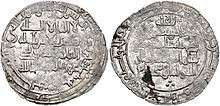Sultan al-Dawla
Abu Shuja (Persian: ابو شجاع; 993 – December 1024), better known by his laqab of Sultan al-Dawla (Persian: سلطان الدوله, "Power of the Dynasty"), was the Buyid amir of Fars (1012–1024) and Iraq (1012–1021). He was the son of Baha' al-Dawla.
| Sultan al-Dawla | |||||
|---|---|---|---|---|---|
 Coin of Sultan al-Dawla | |||||
| Amir of Oman | |||||
| Predecessor | Baha' al-Dawla | ||||
| Successor | Abu Kalijar | ||||
| Amir of Fars | |||||
| Reign | 1012–1024 | ||||
| Predecessor | Baha' al-Dawla | ||||
| Successor | Abu Kalijar | ||||
| Amir of Iraq | |||||
| Reign | 1012-1021 | ||||
| Predecessor | Baha' al-Dawla | ||||
| Successor | Musharrif al-Dawla | ||||
| Born | 993 | ||||
| Died | December 1024 Shiraz | ||||
| Issue | Abu Kalijar | ||||
| |||||
| Father | Baha' al-Dawla | ||||
| Religion | Shia Islam | ||||
Biography
Abu Shuja lived in Baghdad during his youth. Shortly before Baha' al-Dawla's death, he named Abu Shuja as his successor. Upon succeeding his father, he took the title Sultan al-Dawla wa 'Izz al-Milla ("Power of the Dynasty and Glory of the Community").[1] Travelling to his father's capital in Shiraz, he did seek for the traditional investiture by the Abbasid caliph, but instead had the required materials sent to him. He entrusted his oldest brothers Jalal al-Dawla and Qawam al-Dawla with the governorships of Basra and Kerman, respectively.[1] He stayed in Persia for a long time; when he returned to Iraq three years later, he only went to Ahvaz to meet with his governor.
In 1018 Sultan al-Dawla again came to Iraq, in an attempt to maintain friendly terms with the neighboring Amirate of Mosul. Qawam al-Dawla, taking advantage of his brother's presence in the west, invaded Fars with the support of the Ghaznavids. The attack failed, Qawam al-Dawla's marked the division of the Buyid state. After repulsing Qawam al-Dawla's attack, Sultan al-Dawla returned to Iraq in order to solidify his rule there. The marchlands of the region, which had long resisted Buyid authority, were finally subjugated.
The Turkish mercenaries, however, became discontented over the presence Sultan al-Dawla's Daylamite troops. They therefore raised a brother of the amir, Musharrif al-Dawla, as their ruler in 1021.[2] After a long series of negotiations, Sultan al-Dawla recognized his brother as "King of Iraq", in exchange for the latter's submission as a vassal. Sultan al-Dawla, however, wanted to retain direct rule over the region, and he invaded with his army. His defeat by Musharrif al-Dawla's forces put an end to this plan, and Iraq became fully independent. The concept of the senior amir temporarily died; each region of the Buyid state was now ruled independently of one another. Having overseen the fragmentation of the Buyids, Sultan al-Dawla died in Shiraz in December 1024. He was succeeded in Fars by his son Abu Kalijar.
References
- Bosworth 1975, pp. 296–300.
- Nagel 1990, pp. 578-586.
Sources
- Bosworth, C. E. (1975). "Iran under the Buyids". In Frye, R. N. (ed.). The Cambridge History of Iran, Volume 4: From the Arab Invasion to the Saljuqs. Cambridge: Cambridge University Press. pp. 250–305. ISBN 0-521-20093-8.CS1 maint: ref=harv (link)
- Nagel, Tilman (1990). "BUYIDS". Encyclopaedia Iranica, Vol. IV, Fasc. 6. London u.a.: Routledge & Kegan Paul. pp. 578–586.CS1 maint: ref=harv (link)
| Preceded by Baha' al-Dawla |
Buyid amir of Fars 1012–1024 |
Succeeded by Abu Kalijar |
| Buyid amir of Iraq 1012–1021 |
Succeeded by Musharrif al-Dawla |
